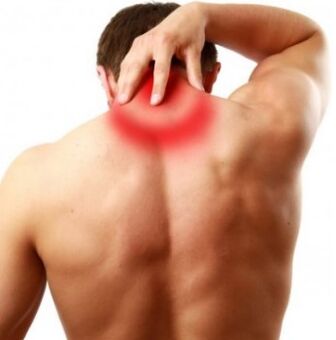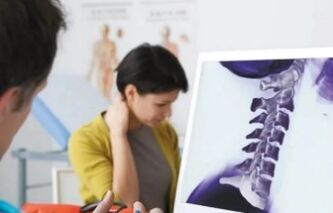Osteochondrosis is a disease of the spine characterized by changes in the cartilage of the intervertebral disc and reactive processes in surrounding tissues.
Neck bone and chondropathy spineIts manifestation is different from thoracic and lumbar osteochondral disease.The symptoms of cervical osteochondrosis are related to the anatomical characteristics of the cervical spine.The size of the vertebrae in the cervical area is smaller than that of other departments.The cervix is constantly under the burden, holding the head, and it is very mobile.

Causes of osteochondrosis
First, the cause of disease development is due to age-related aging in the human body and the destruction of bones and cartilage.The following causes of osteochondrosis can also be called:
- Violate posture,
- Reduce exercise due to a sedentary lifestyle,
- Excessive weight is the result of metabolic disease, with loads on the intervertebral discs.
- Genetic factors,
- Long-term physical exercise,
- Spine abnormality.
A unified physical exercise, proper nutrition and a healthy lifestyle will greatly reduce the possibility of developing this disease and reduce the impact on overall health.
Symptoms of cervical osteochondrosis
The manifestations of cervical osteochondrosis are different from other spinal symptoms.This is due to the fact that the cervical spine has different structures and is very close.Therefore, any displacement is manifested by severe pain.In addition, nerve bundles and arteries are often sandwiched into the cervical spine.
Neck osteochondral disease in the spineIt is manifested by the following symptoms:
- The feeling of pain - pain can be felt in different parts of the body.This is due to the fact that nerve ends and muscles sandwiched into the corresponding part of the body.
- Due to the pinching of the nerve ends that lead to motor activity, the weakness of the upper limb itself is its own.
- The difficulty of turning the head is due to changes in the structure of the intervertebral disc, the appearance of bone formation, and the appearance of vertebrae in the neck area.
- Low sensitivity.
- Due to arterial clamping, weakness and dizziness appear, which ensures blood and nutrition for the brain.
- Reduce hearing and vision - occurs in the final stages of the disease when blood circulation in the cerebellum is disturbed.
Signs of cervical vertebrae symptoms in osteochondrosis
- Rine syndrome - characterized by the pinching of the cervical nerve bundle.This is manifested by the severe pain that can be felt on the shoulders.
- Vertebrate Syndrome - manifested by the strongest headache, pain in the temple and the back of the head.
- Reflex syndrome - characterized by severe pain in the cervical area and can be enhanced with any head movement.The pain can move to the shoulders and chest.
- Cardinal Syndrome - A similar attack to an angina, which is difficult to determine.
The degree of development of cervical osteocartilage degeneration
As it develops, the disease passes through several stages.Each stage has its own characteristics and is characterized by certain characteristics.
- The first stage.The bone crystal tissue of the vertebrae gradually began to collapse.The symptoms of the disease are not obvious.And, often, they are not noticed, but rather they are associated with fatigue and pain with fatigue and stress.
- Stage 2.At height, the disk starts to decrease and cracks appear on it.The patient experiences persistent pain, weakness, and numbness on his face.
- Stage 3.Disc drops begin to form, and cervical blood vessels and muscles are damaged.Some people complain about dizziness and pain in the back of the head.
- Stage 4.Bone tissue that protects the vertebrae from excessive loading begins to grow, so the nerve ends are pinched.The stiffness of the movement, damage to the adjacent joints.
Dangers of cervical bone and chondropathy
A large number of nerves and arteries are located in the cervical area, providing nutrition to the brain.If it violates its work, the brain will not be able to obtain enough nutrition to achieve normal functioning.This condition can violate a person's motor activities, resulting in pain in the limbs and loss of coordination.
In the advanced stages of osteochondrosis, ischemia, stroke and many diseases that are dangerous to human life may develop.
Therefore, seeking medical help is recommended when any symptoms associated with the disease occur.
Diagnosis of cervical spine
The following types of diagnostic methods are used to examine spinal diseases:
- X-ray pictures are an ineffective way to diagnose this disease.
- MRI (magnetic resonance imaging) shows bone structure, forming intervertebral disc hernia and its size,
- Compared to MRI, CT (computed tomography) is not effective because with the help of this diagnostic method, it is difficult to determine the size of the hernia.
- When total blood flow is disturbed, use ultrasonic double-strand scanning.This test shows that there are obstacles in the current speed of blood flow and along the way.
Treatment of cervical osteochondral disease

Depending on the situation, cervical osteochondral disease of the spine should be treated in the complex.Positive effects can also be achieved through a comprehensive personal approach that includes medication therapy, surgical physiology, physical therapy exercise, massage and traditional medicine.
During the intensification period, treatment of spinal cervical osteochondrosis is designed to increase blood circulation to eliminate muscle cramps.In this case, medications and vitamin complexes are prescribed to improve blood flow, anti-inflammatory and painkillers.
Media Physical Education Osteochondral Disease in the Cervical Area
The therapeutic effect is visible in gymnastics and the risk is less in the recovery phase.The principle of physical therapy exercises is to restore blood flow to damaged parts of the body.When practicing physical therapy exercises, patients should not feel pain and inconvenience.
A series of exercises in the cervical spine are designed to strengthen the neck muscles and can also prevent the development of the bone and cartilage of the cervical spine.
Osteochondral disease of cervical vertebrae
Massage is performed to strengthen the tone of the muscles and relieve pain.Different massage methods are performed according to the stage of the disease development.Classic massage techniques include:
- Touching - This technique is about the effect on the skin surface layer.The massage begins in the clavicle area and continues with Clavicula and armpits.
- Squeeze - In this case, the effect during massage occurs on the deeper layers of the skin.Beat the neck with your thumb and index finger, performing movements to capture the skin, similar to squeezing.
- Friction - Perform exercises to warm the skin and relax the skin to improve blood supply to the cervical cervical area.
- Kneading - has special limitations as it affects the deep lying fabric.If the technique is performed incorrectly, the patient can be harmful.
If the patient's pain occurs on only one side, the massage should start from the healthy part of the neck and gradually move to that part of the cervical area where the pain occurs.
Massage can be done at home and in medical institutions.However, during implementation, you should be very cautious so as not to cause worsening of the disease or not worsening.
Prevent cervical osteochondral disease
To prevent the occurrence and development of this disease, it is recommended to follow simple rules:
- Live a healthy lifestyle, exercise physically, and visit the swimming pool regularly;
- Diversified diets with foods rich in magnesium and calcium;
- As for sedentary work, it is necessary to warm up a few times a day.
- For sleep, you should choose an orthopedic mattress and a comfortable pillow.






















